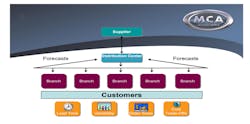Fashions change, seasons change, and so does your supply chain. When was the last time you looked at your entire supply chain process to determine if it’s keeping up with the times? If you have not examined your inventory and supply chain drivers in some time, it’s time to take a look at how some new innovations can impact profit, service level and working capital improvement. Fortunately, even small companies can look and act big, challenging their thinking about their supply chains and implementing practical and realistic solutions.
INVENTORY OPTIMIZATION
If you happen to be an advocate of “lean thinking,” then this discussion may well be right up your alley. If you are new to lean thinking it’s not some new weight loss program, and it doesn’t mean “Leave Everything Alone Now.” This discussion will introduce you to how at least one aspect of this philosophy can be incorporated into your organization, strategically and tactically, in a new and different way.
If your goal is to have the right inventory, at the right place, at the right time, then you are trying to optimize your inventory investment. You may be familiar with how pricing and gross margin analytical software allows you drill down into how you price products, customers, etc.; develop what-if scenarios; and see the potential results of pricing policy decisions and their impact on the goal of maximizing gross margin.
What margin is to pricing optimization, service levels is to inventory optimization. Inventory optimization (IO) is a subset of the broader analytics — business intelligence — which in the process of collecting, storing and analyzing data enables more intelligent supply chain decisions to unlock working capital while maintaining or improving your desired service levels. IO views inventory as a strategic asset, not as a problem.
IO software, applied to your inventory and supply chain decisions, performs a rigorous analysis of your inventory. It uses the business intelligence you obtain to identify specific changes to inventory stocking and replenishment processes and decisions, changes to the distribution network, and correlate inventory investments to product revenue and profit generation opportunities. I recently heard IO defined and then stated in a few different ways that make a lot of sense:
The minimization of costs and the maximization of revenue and profits, through improved visibility and stocking strategies.
For multi-location distribution networks, the inventory level in one location can affect the ability to achieve inventory and service level goals in another.
For instance, if you set inventory levels at location “A” to “X,” what do you need to set inventory levels at location “B” to achieve “Y,” when “B” is the source of inventory for “A”? The only way to correctly answer this question is to determine the total inventory for all locations simultaneously, taking into account all the various dependencies and sources of variability within the distribution network. It comes down to identifying smarter inventory replenishment policies and holding rules that align your company’s inventory with your go-to-market strategy. The IO approach, and the software tools available to carry it out, deliver desired/user-specified customer service levels at minimum total distribution network inventory cost, while allocating inventory most strategically among the stocking locations.
The word “simultaneously” is a key word, considering the impact that inventories have at any given level, on upstream locations (a distribution center or your supplier) and downstream locations (your stocking branches). Advocates of IO say, “Look at the total distribution network,” whereas traditional ERP systems often just look at the inventory requirements at each location or echelon separately in a “transactional based look.”
When you consider the benefits of IO, it’s surprising many companies don’t review and/or update basic safety stock decisions; review their demand and lead-time supply variability on a regular basis; and are still “ball-parking” their inventory decisions related to paying freight or hedging against commodity price increases. They may not have a good understanding of what the cost versus inventory trade-offs really are.
If we accept the premise that the best you can do now is to make these “non-simultaneous” decisions, then maybe a more “scientific” approach has merit, one that enhances and leverages your ERP investment without having to replace your ERP system.
The rationale. Some companies believe they have already optimized inventory through their ERP system’s applications capabilities, as far as those capabilities allow. They are now looking for tools that manage safety stocks, lead times and replenishment/re-order frequency decisions. They want to attain desired service level objectives, in a more intelligent manner, while recognizing that less inventory does not have to translate into lower service levels.
Additionally, they are using IO analytics to drill-down to specifics and discover a lot of things they didn’t know before, such as providing differing service levels by product or group or location, or when adding branch or two. In today’s environment, it’s not enough to just monitor inventory control efforts by running reports from your computer system to measure inventory turns. Why? These actions are not directly concerned with transforming inventory management into a profit and service level enhancer. This is where IO enters the picture. Your stocking strategies become very important, particularly if you relate it to your business objectives, to specific item/product attributes (fast movers, slow movers, new products, critical products), demand expectations and supply characteristics.
INVENTORY DRIVERS
The challenge of IO can be even more daunting in “multi-echelon” distribution networks (see figure below) where you have product stored at a central point (a distribution center (DC) or hub), and the DC is the internal supply to your branches. It’s called the hub-and-spoke” distribution model.
IO’s nuts and bolts involve carefully setting and monitoring the specific “drivers” of inventory management that are interrelated and using information gathered from each other. An analysis of these drivers, and visibility into them, can provide answers to “what if” questions, as well as provide the diagnostic tool into inventory rules, metrics and measurements. These “drivers” are:
- Desired service levels
- Forecasting, or what we will call “flowcasting” later in the article
- Replenishment order frequency
- Lead time
Desired service level. This involves setting and monitoring the desired service level performance of the inventory itself down to each SKU. Most ERP systems, alone don’t provide service level analysis and reporting. Rather, you must analyze demand history, demand variation, GMROI and lost sales.
Demand forecasting. This requires that you have an understanding that goes above and beyond simply having knowledge of recent sales history. It requires an understanding of “demand-pull” and “continuous flow” concepts (flowcasting) and their use to develop appropriate target inventory levels for each and every product.
Replenishment order frequency. This is another critical aspect of inventory optimization. Replenishment is not just reordering. It’s not just about the cost to generate a purchase order, but rather how much you order, each time you order. That’s where each order costs your company money. Supply chain professionals often make the mistake of ordering to sustain perceived service levels or for other perceived benefits, such as free freight. But if service level and continuous flow (flowcasting) can be utilized correctly, there is no need to be in the dark. More accurately pinpointing an optimum or best order frequency can by itself account for significant inventory reductions and service level enhancement.
Lead time. Anticipating lead-time with accuracy goes beyond simply determining a supplier’s lead-time from past averages. It not only requires an in-depth assessment of the supplier’s overall performance, but also being able to understand its impact on all locations within the distribution network to minimize or eliminate those self-defeating practices such as having to “over order” or “over transfer” in an attempt to compensate for variations in supplier performance.
In Part 2 of this series, we will help you analyze hub-and-spoke distribution networks.
Howard Coleman and his team at MCA Associates helps distributors and manufacturers implement continuous improvement solutions focused on business process re-engineering, inventory and supply chain management, sales development and revenue generation, information systems and technology, organizational assessment and development. MCA Associates may be contacted at 203-732-0603, or by email at[email protected]" target="_blank"> [email protected].
About the Author
Howard Coleman
The author is the principal of MCA Associates, Derby, Conn., a management consulting firm founded in 1986. MCA implements continuous improvement solutions focused on business process re-engineering, inventory and supply chain management, sales development and revenue generation, information systems and technology, organizational assessment and development, and succession planning. You can contact him by phone at (203) 732-0603 or by e-mail at [email protected].

